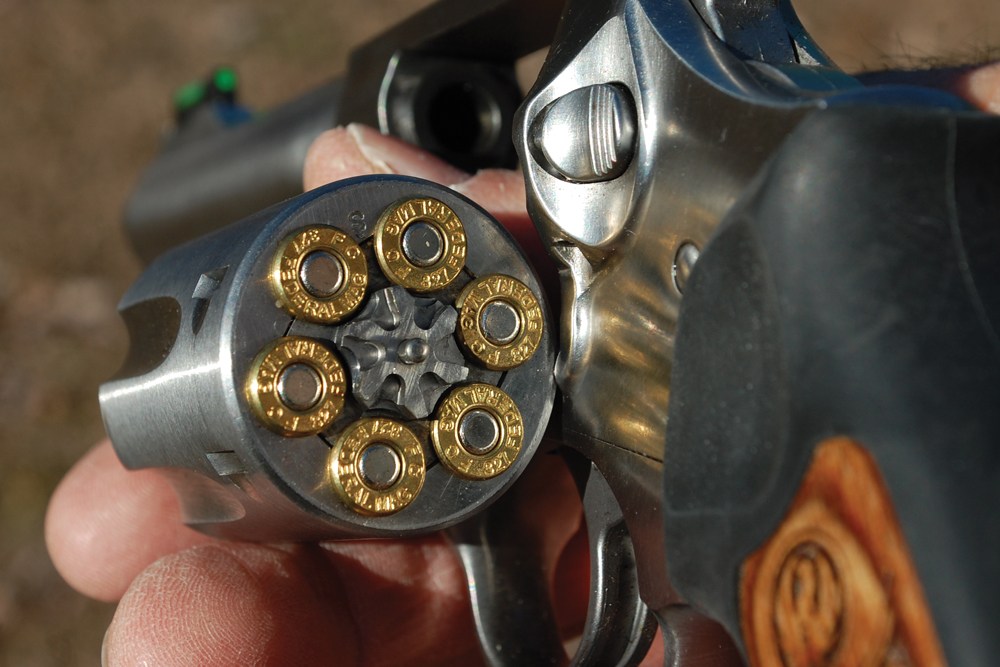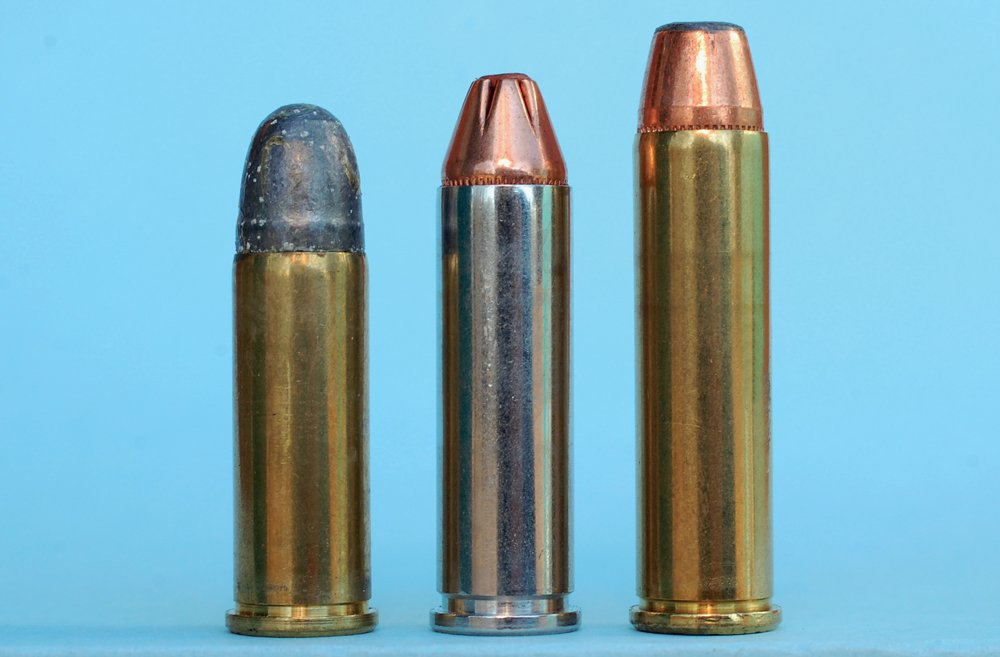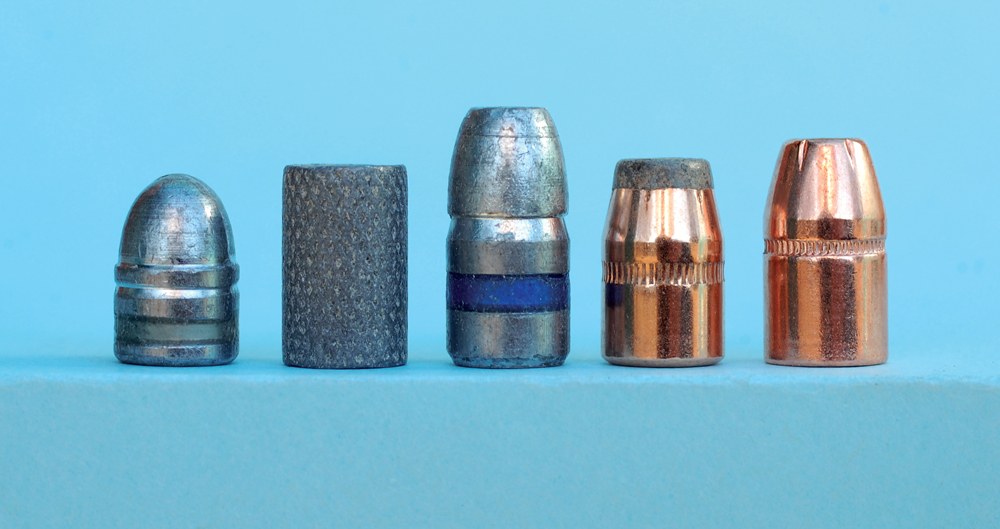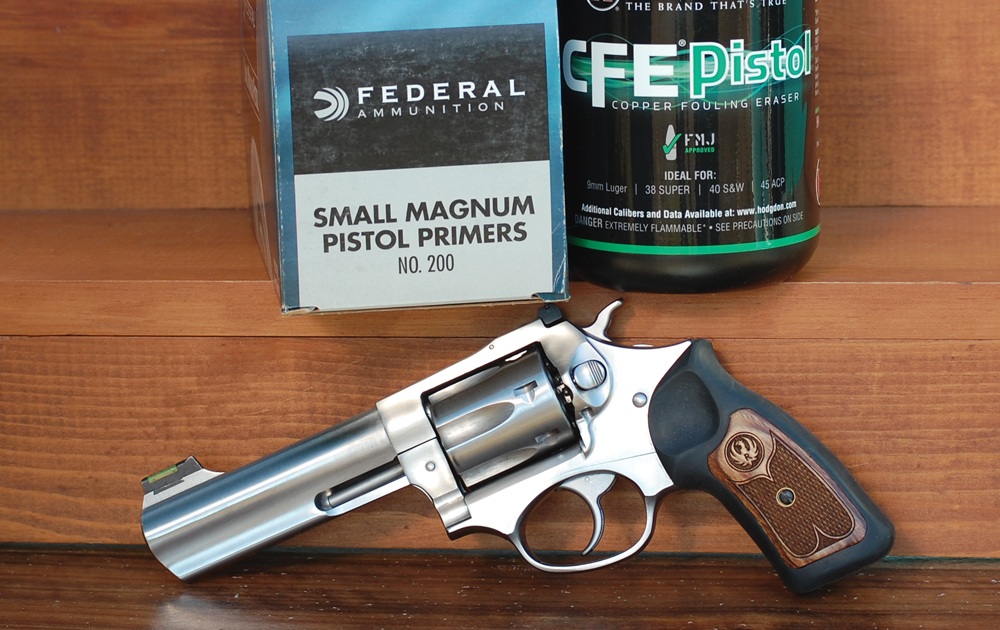

Fired from snappy revolvers and with velocity to spare, the .327 Federal Magnum is redefining the often-maligned caliber for the better.
Handgun design and usage have been strongly influenced by .32-caliber cartridges for well over a century. The majority of the .32-caliber cartridges of the past were pretty anemic, but still, most of them were quite popular for personal defense. Nowadays, if you go out armed with a .32, folks think you’re demented.
Bad guys seem to have gotten a lot tougher in the past few decades, too. Back in the 1920s and 1930s, folks thought it was perfectly logical to arm themselves with a slim, hammerless automatic pistol or a small revolver chambered for one of the many .32-caliber cartridges available.
Back then, good guys didn’t worry too much about shooting a bad guy, and if you shot a crook, they’d probably give you a medal rather than throw you in the juzgado. There were no powerful antibiotics then, so anyone whacked in the gizzard with a .32 (or any) slug, was probably going to get an infection, and be headed to the last roundup.

Evolution works with cartridges, too, and today we have what is perhaps the quintessential expression of the .32-caliber in the .327 Federal Magnum. Introduced in 2008, the new .327 is one of the most powerful .32-caliber rounds to ever be chambered in a handgun. Federal currently offers three factory loads for the .327 and their performance is impressive. This ammo includes tough, jacketed hollowpoint and soft-point bullets at velocities unheard of only a few years ago.
The .327 fires 85-grain bullets at 1,500 fps and 100-grain bullets at about 1,450 fps. Muzzle energy of the latter round is about 467 ft-lbs. By comparison, the .357 Magnum generates 540 ft-lbs and the .44 Magnum, 860 ft-lbs.
The early .32s were low powered and designed to fit in small semi-autos or revolvers. The first attempt at a high-powered .32 was in 1984 with the introduction of the .32 H&R Magnum. This was a joint development of the Harrington & Richardson Company and Federal Cartridge. While a big improvement over the old-timers, it was still of modest power.
Like the .357 and .44 Magnums before it, the .32 H&R followed the example of lengthening an existing case and upping the pressure for more velocity. The .32 H&R case is .155 inch longer than the .32 Long, and the .327 is .128 inch longer than the .32 H&R. Plus, the .327 operates at much higher pressures than other .32s.
Although the .32 H&R languished, the .327 built on the example, and after a slow start, sixgunners have recognized the ballistic virtue of the .327 and the trim guns that shoot it. It finally seems to have caught on, but interestingly, with two distinct groups of shooters. This is reflected in the types of firearms the gun companies have built for it, aimed at two sometimes disparate groups.

In one camp are the traditional outdoorsmen who would no sooner go out of the ranch house without their sixgun than without their pants and boots. It’s just a part of getting dressed. The .327 is eminently suitable for hunting a variety of small game and medium-size varmints, protection from venomous snakes, or tacking up wanted posters, so it’s right at home on the trail.
Everyone would agree that in the field a rifle is better in almost all instances, but a long gun is most unhandy to tote around. A compact yet powerful revolver, however, rides nicely in a belt holster, barely noticed until it’s needed. Then, with one quick hand motion, it’s ready for service.
For these folks, Ruger and others have brought out revolvers that are about perfect field guns. Many of these new guns have medium-length barrels and adjustable sights that allow the shooter to fit the gun to the load, rather than the other way around with fixed sights.
Many in the other group of .327 aficionados could care less about roaming the backcountry. For them, it’s the urban jungle that presents their challenges, as the members of some tribes are not always friendly. For these urban road warriors, the powerful .327 in a trim, lightweight revolver is a godsend, since it can be carried unobtrusively until needed for protection.
A .327 revolver offers a lot of power in a small package, and this translates into a fight-stopping combination for the armed citizen and has subtly changed the perception and reality of armed carry. Faced with the realities of today, many citizens have chosen to arm themselves with a .327.

Both groups are right. The .327 Federal Magnum is perfectly comfortable in either situation and offers the best of all worlds. Not only is it sufficiently powerful to be a self-defense round in its own right, it will handily dispatch game as large as coyotes, and light loads make for a delightful afternoon of good ol’ plinking fun.
The revolvers in .327 available at this writing include the Ruger Single Seven in 4.62-, 5.5- and 7.5-inch barrels; the compact LCR; and the midsize SP101 with a 4.2-inch barrel. Taurus offers a couple of snubnose guns – one with a 2-inch barrel and the other with a 3-inch ported tube. The bottom line is that a diverse selection of quality .327 guns is available to the urban shooter or outdoorsman.
I was unable to resist the tug of the .327 (OK, I admit it, I’m a weak person), so I purchased a new Ruger SP101. It is a beautiful little gun with a brushed stainless finish, and the action is as smooth as silk. The trigger pull was a little heavy, but a set of Wolff springs fixed that in about 10 minutes. The only thing I don’t like about it is the fiber-optic front sight. As soon as I can find a plain black blade, it’s getting replaced.
I checked .327 and .32 H&R factory loads in the SP101, then brewed up some representative handloads to see what the round would do. The results are shown in the accompanying load table. Basically, the groups at 20 yards were quite good, especially considering that I had a hard time holding that green blob of a front sight the same for each shot.

I also tried some .32 S&W factory loads from Federal and Winchester, and the results were also excellent. They would be perfect for bunny busting, potting fool hens or dispatching rattlers. I didn’t shoot any .32 ACP loads, but the SP101 chambers and ejects them A-OK. Those results are also shown in the load table.
Factory fodder for the .327 is good ammo, but it isn’t cheap, so the economical answer is handloading. This, fortunately, is a snap, and the same dies and shell holders used for the .32 Long and .32 H&R will work just fine for the .327, too.
Federal uses their No. 200 small pistol magnum primers, and I did likewise in my .327 handloads, though I used Federal No. 100s for the other two cartridges. I lucked into a good quantity of Federal nickel-plated .327 cases, so I used them for my test loads. I used Starline cases for the .32 H&R and Winchester for the .32 Long.
Suitable powders for the .327 really fall into two categories. For the highest velocities with 100- to 115-grain bullets, Winchester 296 (aka Hodgdon 110) and Lil’Gun are good choices. For medium-power loads, you just can’t beat Hodgdon’s new CFE Pistol, although HS-6, Universal and AutoComp are also good. For what used to be called “gallery loads,” Bullseye, Winchester 231 and TiteGroup with cast bullets are the ticket to low recoil, a mild report and small groups.
When it’s all said and done, my solution to loading the .327 was very simple. I just kept the charges a bit under maximum. Accuracy and velocity were fine, and I had not a single case failure or any trouble ejecting a case. However, if you find yourself with a lot of .32 H&R cases and few .327s, it’s no problem, as the H&R brass makes up into accurate and powerful ammo for use in a .327 wheelgun.

The .327 Federal is a great little cartridge, but it is not without its foibles. It offers a lot of performance, but at a price. Yes, factory ammo is expensive, but that’s not what I’m talking about. Chamber pressure and noise are the costs.
The Maximum Average Pressure (MAP) allowed for the .327 by SAAMI is 45,000 psi. By contrast, MAP of the .357 Magnum is 35,000 psi and 36,000 psi for the .44 Magnum. So, reloaders should not use powder charges heavier than those in the loading manuals. Actually, handloads a bit below maximum offer plenty of power and trouble-free functioning.
Another cost of the .327 is a very loud muzzle blast. Unless a grizzly is chewing on your leg or a bad guy is closing fast, the .327 should never be fired without hearing protection.
However, this is not an insurmountable problem for the industrious .327 shooter. A tremendously useful attribute of a .327 revolver is its ability to shoot a variety of shorter rounds. The .32 H&R, .32 S&W, .32 S&W Long, and even the .32 ACP (because it’s actually a semi-rimmed case) can be safely fired in a .327. Hornady makes a .32 H&R round with an 85-grain XTP bullet at 1,150 fps that is a terrific load for the .327. Federal also makes .32 H&R ammunition.
But, the real solution is to handload the .327 to match the shooter’s need. Cases, bullets and powders are readily available, so a load for just about any purpose can be tailor-made. Plus, handloads are extremely inexpensive compared to factory fodder.

So, in the .327 Federal Magnum we have the most versatile and powerful modern-day .32-caliber cartridge to achieve broad-based popularity. Modern ammunition and new firearms are available for it, and it can be handloaded to suit the shooter’s needs and pocketbook. While the .32 ACP and .32 S&W Long in classic pistols like the M-1903 Colt and S&W M-31 are fun to shoot, the .327 can be easily loaded to the power levels of most of those earlier rounds, in addition to power levels unheard of for those older rounds.
The .327 offers a broad spectrum of performance, is economical to handload and shoot, and at the same time is a powerful round for personal protection. The shooter looking for a small or mid-size handgun with pizzazz would do well to consider the versatile .327 Federal Magnum.
Editor's Note: This article is from Gun Digest 2017, 71st Edition.

Next Step: Get your FREE Printable Target Pack
Enhance your shooting precision with our 62 MOA Targets, perfect for rifles and handguns. Crafted in collaboration with Storm Tactical for accuracy and versatility.
Subscribe to the Gun Digest email newsletter and get your downloadable target pack sent straight to your inbox. Stay updated with the latest firearms info in the industry.

![Best Concealed Carry Guns In 2025 [Field Tested] Wilson Combat EDC X9S 1](https://gundigest.com/wp-content/uploads/Wilson-Combat-EDC-X9S-1-324x160.jpg)


![Best 9mm Carbine: Affordable PCCs [Tested] Ruger Carbine Shooting](https://gundigest.com/wp-content/uploads/Ruger-Carbine-Shooting-100x70.jpg)
![Best AR-15: Top Options Available Today [Field Tested] Harrington and Richardson PSA XM177E2 feature](https://gundigest.com/wp-content/uploads/Harrington-and-Richardson-PSA-XM177E2-feature-100x70.jpg)

I have four Rugers. The .22 LR eight shot, the .32 HR Magnum six shot. the .327 Federal six shot, and the Single Nine .22 Magnum. For Home Defense, I think the .32 HR Magnum is ideal because the homeowner can lay on the carpet or floor and shoot upward to prevent going through walls that go into bedrooms, or can stop at the assailant without an excess of penetration to innocents behind. I shot at a piece of 3.5 by ten inch oiece of redwood and I thought the wind knocked it over, but the .32 HR Magnum did it. The .327 is too loud for indoors but has a very healthy but controllable kick, but the energy is pretty equivalent to a .40 Smith and Wesson.
The author states: “Many in the other group of .327 aficionados could care less about roaming the backcountry.” He meant to say “couldn’t care less” instead of “could care less.”
The expression “Could care less” is valid here too. It’s a kind of hyperbole, like if somebody asks you if you like black licorice and you respond with “I like 5-day-old cold cuts less”. It works because you are saying that it’s so far at the bottom of your preferences that the most positive thing you can say about it is that it’s not at the absolute bottom.
With that said, yes, some sources say that only “couldn’t” is correct. Other sources disagree with this.
I must say that I love my .327 Fed Mag firearms. I have the Taurus w/ the 3 in ported barrel, the Ruger LCR and the LCRx (exposed hammer), the SP101 SS w/ 3 in barrel, the Single Seven SS w/ 5.5 inch barrel, and a Henry lever gun. Yes, I love the .327 which, IMHO, is the most underappreciated chambering in existence, especially considering the other .32 rounds that can be accommodated. Finally, Federal has come out with the “Hammer Down” which is 127 gr, has a muzzle velocity of over 1650 FPS, and is designed for lever guns to take medium size game (deer, antelope, and I would imagine feral hogs). What’s NOT to love about the .327?
I’m glad to see some new discussion about the .327 Federal Magnum.
I’m a proud owner of one of those black S&W 632 Carry Comp Pro 3″ revolvers.
I enjoyed firing a few cylinders of factory loads until S&W ceased production. I retired it to Safe Queen status, and watch the SOLD listings on GunBroker!
I read about every article and forum discussion I could find at the time. One glaring reality was that most of the negative views were from pundits that never tried or owned one. While most of us owners loved ours.
For a long time it appeared the .327 Federal Magnum was going to die a slow death from starvation of interest.
I like the option of five cartridges that it can digest. I like the history of accuracy in that caliber.
I’m encouraged by hearing that Henry chose to support the cartridge. The lack of a long arm was one of the “wait and see” negatives in the earlier posts.
As far as if there is a need… I guess the same question could be asked about the .41 Magnum and 10mm.
I have the Single Seven. Didn’t realize the SP101 in .327 had been reintroduced. I guess I really do need (at least) one more gun. 🙂
Here’s a tip –when you release a new cartridge in the middle of a war make sure people can find some……..
Sadly most 327 guns are not even produced anymore. Something about boxes of 20-25 rounds at over a buck a round for a small cartridge and no available brass is not exactly a selling point……
I don’t mind letting ya try a few rounds that cost less than 10 cents each to make but when I let you burn up 12 to 25 bucks or more of my money I start getting picky ……..
Plus at that price you are not likely to see me at the range burning up personnel defense loads in a hundred lots…..
Hard to get the word out when they are all secreted away as self defense weapons and no one at the range has one or has even heard of one. Ditto trying to buy ammo when the clerk haven’t heard of it- much less carry it.
Even the H&R 32 mag was pretty scarce at the peak of the war and 327 brass was proprietary from federal who didn’t seem to think it was a priority……
And all that is a shame cause it’s one hell of a round. The Mrs and I own one of most types ever made except for the Ruger Black Hawk (8 shot) and the highly priced but excellent made Freedom Arms…..
I highly recommend this round and these guns ……..
A sad story of major mismanagement by Federal……..If they would have built it they would have come ………they squandered the all important initial launch
I may be missing the point but it seems the major advantage of the .327FM is more compact guns? I’m just not sure what other advantage it has over .357. I don’t own either so I’m just curious. Is .327 cheaper per shot than .357 if you buy bullets in bulk?
I have both. I’d say the .327 is just a little easier to tote and shoot than a .357
Of course, b/c .357 & .38 sp are more popular & prevalent, I imagine the ammo is cheaper than .327 (or the other .32s).
Hi Eric, I’m a little late to the party but wanted to reply.
Each caliber has something to offer. I think for a lot of people, what we’re looking for is a balance between power and manageability. Just like the .40 caliber was between the 9mm and .45, the .327 presents something between the .38 and .357, and actually can be as powerful as many .357 loads with noticeably less recoil.
Ammo costs fluctuate depending on the politics of the day. Right now most rounds are much less than they were two years ago. – .327 Federal Magnum seems to be running about $4 – $5 a box more than comparable .38 special and $2 – $3 more than comparable .357 magnum. So why .327 Federal Magnum?
Part of it is having good fire power in a more manageable round. When you’re going to smaller arms, recoil is important. If someone can’t manage the recoil, they are less likely to practice, less likely to carry. Unfortunately there are very few choices for .327. Among the most likely candidate for a carry piece is Ruger’s hammerless LCR. The gun itself is very lightweight, and it has the advantage of firing not only the .327, but .32 H&R and .32 Long as well. It might fire the .32 ACP; I’m not sure of this, I know the Ruger Single Seven will. While many discount anything that starts with 32, others out there believe the .32 H&R Magnum is a reasonable load for self-defense.
I’ll also point out here that Ruger manufactures the LCR in a variety of calibers – .22 LR, .22 WMV, .38, .357, and 9mm, which does muddy the water about “why .327?”
So there are advantages to the .327 Federal Magnum firearm, but those advantages are subjective, depending on the needs and abilities of the shooter. While it seems now only Ruger manufactures new guns, there are others out there when/if you can find them, made by Taurus, S&W, and Charter Arms. The fact these older guns are so hard to come by suggests to me that their owners are very pleased with them and have no desire to sell or trade.
For what it’s worth, one other constant with the .327 Federal Magnum load seems to be that it’s very easy to reload, using existing dies. So for those that do, there’s another plus.
Henry’s Repeating Arms also has four new rifles out this year in .327 Federal Magnum. Etched on the barrel is that they will use .32 H&R magnum as well. Recent reviewers claim it will also fire .32 Long. Not sure I want to test that myself, since an email to Henry’s support said it was only tested with .327 and .32 H&R. Some like to match a pistol with their rifle (rather a bit of the old west there) so this too is a convenience.
I don’t think the average shooter in the U.S. today really practices “economy” in terms of shooting. Is one round cheaper than another? Always. But it’s what we like, what we want. Sometimes it’s what’s new or cool. While the .327 Federal Magnum has been an uphill climb for Ruger and Federal, I think consistently those who buy it love it. It may be a niche market, but it’s a loyal one.
I like shooting .38 and 9mm – but I love shooting my .327.
Eric – all the comments below are great, but the main point that addresses your question is: cylinder capacity. The .327 (and .32HRM) are sufficiently slimmer than the .38/357 for the factory to drill one extra hole in the cylinder. In other words, in the same size gun, six 32s vs five 357s.
Ed Becka
SSG (R) USA/TXARNG
SGT (R) NCSO/LOCSO
Oops; did not mean to imply, in that first line, that I include the .32 ACP in the .32 S&W family.
I love this entire family of cartridges. The only one I don’t reload is .32 ACP.
I tend to load .327 Federal a bit mild. I have a few good loads using Win 296, but my favorite powder is 800-X. I have been able to work up accurate loads for every bullet weight I have tried with this. All of them a full grain or more below maximum.
I find that my handloads in .32 H&R are the most accurate of the four, at least for what I’ve tried so far. However, I have a load in .32 S&W which will group under 2″ at 25 yards from both my revolvers, which I can shoot all day for a few dollars.
I do caution that brand of brass can be important, especially for .32 S&W and .32 S&WL. As an example, I have one load which will group under two inches at 20 yards with one brand of brass, and runs over 6″ with another.